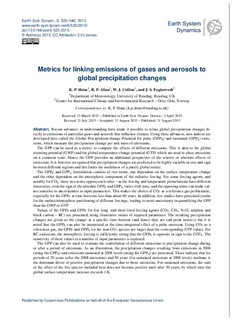| dc.description.abstract | Recent advances in understanding have made it possible to relate global precipitation changes directly to emissions of particular gases and aerosols that influence climate. Using these advances, new indices are developed here called the Global Precipitation-change Potential for pulse (GPPP) and sustained (GPPS) emissions, which measure the precipitation change per unit mass of emissions. The GPP can be used as a metric to compare the effects of different emissions. This is akin to the global warming potential (GWP) and the global temperature-change potential (GTP) which are used to place emissions on a common scale. Hence the GPP provides an additional perspective of the relative or absolute effects of emissions. It is however recognised that precipitation changes are predicted to be highly variable in size and sign between different regions and this limits the usefulness of a purely global metric. The GPPP and GPPS formulation consists of two terms, one dependent on the surface temperature change and the other dependent on the atmospheric component of the radiative forcing. For some forcing agents, and notably for CO2, these two terms oppose each other – as the forcing and temperature perturbations have different timescales, even the sign of the absolute GPPP and GPPS varies with time, and the opposing terms can make values sensitive to uncertainties in input parameters. This makes the choice of CO2 as a reference gas problematic, especially for the GPPS at time horizons less than about 60 years. In addition, few studies have presented results for the surface/atmosphere partitioning of different forcings, leading to more uncertainty in quantifying the GPP than the GWP or GTP. Values of the GPPP and GPPS for five long- and short-lived forcing agents (CO2, CH4, N2O, sulphate and black carbon – BC) are presented, using illustrative values of required parameters. The resulting precipitation changes are given as the change at a specific time horizon (and hence they are end-point metrics) but it is noted that the GPPS can also be interpreted as the time-integrated effect of a pulse emission. Using CO2 as a references gas, the GPPP and GPPS for the non-CO2 species are larger than the corresponding GTP values. For BC emissions, the atmospheric forcing is sufficiently strong that the GPPS is opposite in sign to the GPPS. The sensitivity of these values to a number of input parameters is explored. The GPP can also be used to evaluate the contribution of different emissions to precipitation change during or after a period of emissions. As an illustration, the precipitation changes resulting from emissions in 2008 (using the GPPP) and emissions sustained at 2008 levels (using the GPPS) are presented. These indicate that for periods of 20 years (after the 2008 emissions) and 50 years (for sustained emissions at 2008 levels) methane is the dominant driver of positive precipitation changes due to those emissions. For sustained emissions, the sum of the effect of the five species included here does not become positive until after 50 years, by which time the global surface temperature increase exceeds 1 K. | |
